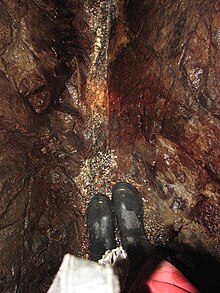Sole (mining)
In mining, the bottom is a height level (a mostly horizontal plane) of a mine on which the mines have been driven . The boundary surface of a bottom (horizontal) or inclined pit with the shortest distance to the center of the earth, generally its "floor", is called the bottom in mining.
Sole as a pit
When aligning a deposit, floors are excavated using shafts in civil engineering . In a figurative sense, the floors of a mine represent individual floors with which the mountain range is divided. The advantage of the alignment means of soles to alignment by means of studs is that the seigeren distances can determine the soles to each other by engineering judgment. In the Ruhr mining industry , for example, the soles are between 200 and 400 meters apart. Sections in the deposit can be created through the individual levels, which are used for mining the deposit, extraction , ventilation and dewatering . There is a main route network on each level, which is divided into routes and crosscuts . A distinction is made between single-sole construction and multi-sole construction. In multi-sole construction, there are always at least two levels in operation, a conveyor level and a weather level . The upper sole always serves as the weather sole. The rock that is located between two levels in the area of a cross passage is called the cross passage department. The prerequisite for this is that the mineral reserve present in the mountain body is loosened and transported away from the same cross passage. Soles are often labeled according to their task. In addition to the extraction and weather bed, there is also the construction floor or excavation floor intended for the purpose of mining the deposit. The sole on which the pit water is collected is referred to as the machine bottom or swamp bottom. A midsole or partial sole is the name given to soles that are placed between the main soles.
Alignment
When aligning the individual soles, the local conditions must be taken into account. Particular attention must be paid to existing tunnels when setting the first underground excavation level. If the first underground excavation level is set too close under an existing tunnel, the tunnel can collapse . It is also possible that the water diverted from the tunnel penetrates through crevices and crevices into the civil engineering. Also problematic are water-rich mountains and floating mountain layers. If possible, the soles are created in such a way that they are water-bearing. This avoids that the pit water accumulating on the respective bottom penetrates to the deeper floors.
Partial soles
In some deposits it is often not possible to exploit the deposit only over a few main levels. In particular, if the distances between the main levels are very large, the rock mass cannot be divided sufficiently for mining . Here it is then necessary to align a corresponding number of partial soles. These partial floors are mostly short and are only aligned via a local crosscut or partial floor crosscut. As a rule, no straightening sections are aligned here. As a result, the individual partial floor crosscuts in the various departments have no connection with one another. The number of partial levels in the individual departments varies depending on the deposit. It may be that a partial level is sufficient in one department, but several partial levels must be created in the other department at the same time. The partial soles of the individual departments are also often at different depths . The partial soles must be connected to the main soles for weather management, conveyance and driving . The connection with the main floor is made by mining peaks or blind shafts. Partial levels are used in potash mining with steep storage and in ore mining with mighty, steep deposits. Partial soles are not used in the moderately inclined and flat positions.
Sole as a level
The miner uses the term " sole " to define the lower boundary surface of a mine. Depending on the type of pit, the miner then calls the bottom of the track, tunnel bottom or shaft bottom. It is irrelevant whether the boundary surface forms an inclined or horizontal plane. In tunnel construction , the bottom of the lower tunnel is used as a reference point to determine the level of the deposit. The bottom of the tunnel is the point up to which the water from the reservoir can be drained off naturally. When determining their location, all reservoir contents are designated as being either above or below the tunnel floor.
Above the bottom of the tunnel, mining can be carried out in tunnel construction , below that only in civil engineering , in which the penetrating water has to be scooped up.
Individual evidence
- ^ Walter Bischoff , Heinz Bramann, Westfälische Berggewerkschaftskasse Bochum: The small mining dictionary. 7th edition, Verlag Glückauf GmbH, Essen 1988, ISBN 3-7739-0501-7 .
- ↑ a b c d Ernst-Ulrich Reuther: Introduction to mining . 1st edition, Verlag Glückauf GmbH, Essen, 1982, ISBN 3-7739-0390-1 .
- ↑ a b c d Albert Serlo: Guide to mining science. First volume, published by Julius Springer, Berlin 1884.
- ^ Ernst-Ulrich Reuther: Textbook of mining science. First volume, 12th edition, VGE Verlag GmbH, Essen 2010, ISBN 978-3-86797-076-1 .
- ^ A b Heinrich Veith: German mountain dictionary with evidence. Published by Wilhelm Gottlieb Korn, Breslau 1871.
- ^ Carl Hellmut Fritzsche: Textbook of mining science. Second volume, 10th edition, Springer Verlag, Berlin / Göttingen / Heidelberg 1962.
- ↑ Explanatory dictionary of the technical terms and foreign words that occur in mining in metallurgy and in salt works and technical articulations that occur in salt works. Falkenberg'schen Buchhandlung publishing house, Burgsteinfurt 1869.
- ↑ Carl von Scheuchenstuel : IDIOTICON the Austrian mining and metallurgy language. kk court bookseller Wilhelm Braumüller, Vienna 1856.
